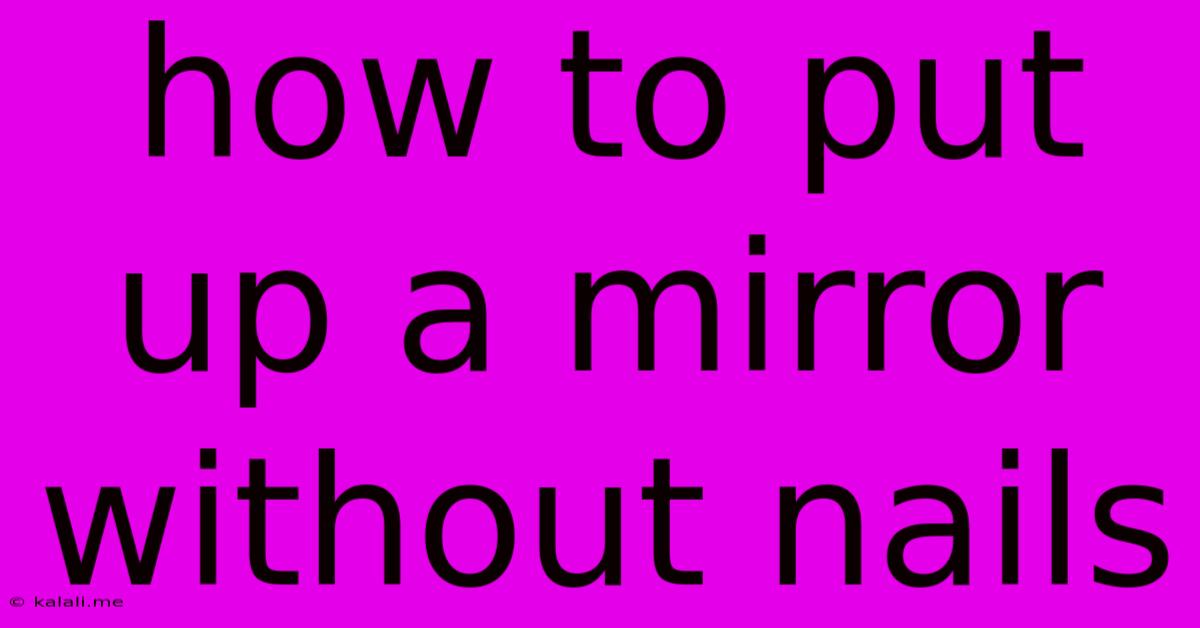How To Put Up A Mirror Without Nails
Kalali
May 22, 2025 · 3 min read

Table of Contents
How to Hang a Mirror Without Nails: Damage-Free Hanging Methods
Want to add a touch of elegance and light to your space without damaging your walls? Hanging a mirror without nails is easier than you think! This guide explores several damage-free methods, perfect for renters, homeowners who cherish their walls, or anyone seeking a quick and easy solution. We'll cover various techniques and materials, ensuring you find the perfect method for your mirror and wall type.
Why Choose Nail-Free Hanging?
Choosing a nail-free method offers several advantages:
- Protects your walls: Avoids holes, cracks, and damage, especially beneficial for rented properties or walls with delicate finishes.
- Easy removal: Mirrors can be easily repositioned or removed without leaving any trace.
- Versatile solutions: Various methods cater to different mirror sizes and wall types.
- Quick and simple: Many techniques require minimal tools and time.
Methods for Hanging a Mirror Without Nails
Here are some popular and effective methods for hanging your mirror without resorting to nails:
1. Adhesive Strips/Hooks:
- Best for: Lightweight mirrors and smooth surfaces.
- How it works: Heavy-duty adhesive strips or hooks are applied to the back of the mirror and firmly pressed against the wall. Ensure the surface is clean and dry for optimal adhesion. Many brands offer different weight capacities, so choose one suitable for your mirror's size and weight.
- Pros: Easy to use, readily available, inexpensive.
- Cons: May not be suitable for heavy mirrors or textured walls; adhesive residue may remain after removal.
2. Command Strips:
- Best for: Lightweight to medium-weight mirrors on smooth surfaces.
- How it works: Similar to adhesive strips, Command Strips are specifically designed for easy removal without leaving residue. They come in various sizes and weight capacities. Follow the manufacturer's instructions carefully for optimal adhesion and removal.
- Pros: Easy removal, minimal residue, widely available.
- Cons: May not be suitable for very heavy mirrors or textured surfaces.
3. Suction Cups:
- Best for: Small, lightweight mirrors and smooth, non-porous surfaces like glass or tiles.
- How it works: Suction cups create a vacuum seal, holding the mirror in place. Ensure the surface is clean, dry, and smooth for optimal suction. Multiple suction cups may be needed for larger mirrors.
- Pros: Inexpensive, easy to use, leaves no residue.
- Cons: Only suitable for small, lightweight mirrors and very smooth surfaces; suction may weaken over time or with changes in temperature and humidity.
4. Mirror Mounting Tape:
- Best for: Medium to heavy mirrors, offering strong adhesion for a secure hold.
- How it works: This specialized tape is designed for heavier objects and provides a strong bond to the wall. It is important to prepare your wall and mirror correctly, and choose the correct tape weight for your mirror.
- Pros: Offers a stronger hold compared to standard adhesive strips, suitable for heavier mirrors.
- Cons: Can be more expensive, may require precise application.
5. Sticky Putty/Glue Dots:
- Best for: Very small and lightweight mirrors, or as supplemental support.
- How it works: Small, reusable putty or glue dots can be used to hold the mirror in place, often used in conjunction with other methods for extra security.
- Pros: Small, easy to use, readily available, ideal for minor adjustments.
- Cons: Not suitable for heavy mirrors, adhesive strength can vary.
Tips for Success
- Clean the surface: Thoroughly clean both the wall and the back of the mirror before applying any adhesive.
- Follow instructions: Always follow the manufacturer's instructions for the specific product you're using.
- Start small: If you're unsure, test the adhesive on a small, inconspicuous area first.
- Consider weight: Choose an adhesive or method that can adequately support the weight of your mirror.
- Multiple points of contact: For larger mirrors, use multiple adhesive strips or hooks for better support and stability.
By following these tips and choosing the right method, you can successfully hang your mirror without nails, adding a stylish touch to your home without causing any damage. Remember to always prioritize safety and choose a method that is appropriate for the weight and size of your mirror, as well as the type of wall surface you have.
Latest Posts
Latest Posts
-
How Old Was Jesus When The Magi Came
May 22, 2025
-
Bread Not Rising In Bread Machine
May 22, 2025
-
How To Address More Than One Person In An Email
May 22, 2025
-
The Broker Guardians Of The Galaxy
May 22, 2025
-
Whats The Difference Between A Coat And Jacket
May 22, 2025
Related Post
Thank you for visiting our website which covers about How To Put Up A Mirror Without Nails . We hope the information provided has been useful to you. Feel free to contact us if you have any questions or need further assistance. See you next time and don't miss to bookmark.